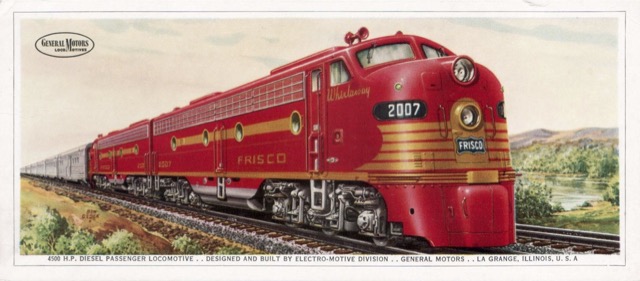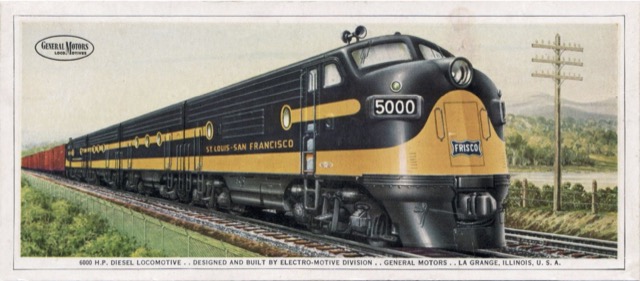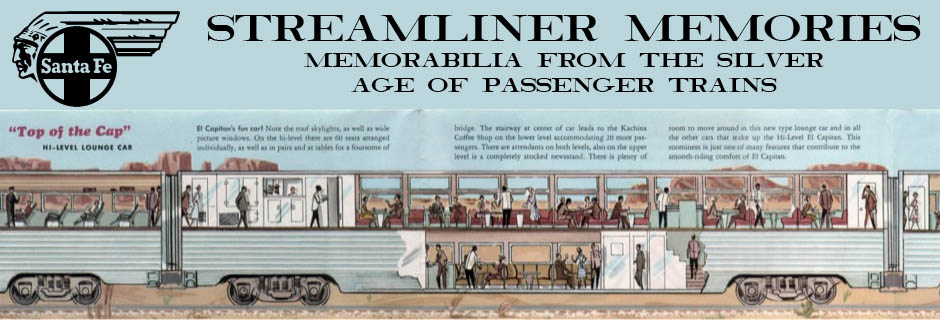Frisch liked the six E7 locomotives (numbered 2000 to 2005) it purchased in 1948 for the Meteor and Texas Special so well that it soon added sixteen E8s (which were first made in 1949) for its other passenger trains. This locomotive card depicts the second E8 to come off the production line.

Click image to download a 500-KB PDF of this card.
The card shows the locomotive painted bright red with gold stripes. As Mike Condren’s Frisco web pages show, they were all named after famous horses. The locomotive on this card is called Whirlaway, after the winner of the 1941 Triple Crown. At the same time, the E7s were retroactively given horse names and soon were repainted to match the E8s.
Condren’s photos show that the E8 locomotives were originally delivered with the gold stripes shown on the card. But for some reason these were soon modified with a more complicated scheme involving thin white stripes around the gold stripes. Later, the gold/gold-&-white stripes were replaced with yellow stripes. Eventually, the stainless-steel panels were removed and the scheme was simplified with a solid yellow cigar band in front and no yellow or gold stripes on the side. Finally, the locomotives were simplified again with a single white stripe at porthole level, a configuration that might have looked good on a GP or SW unit but that didn’t really fit over the nose of a streamlined E unit.

Click image to download a 500-KB PDF of this card.
This locomotive card for the Frisco’s first F3 locomotive shows that it began life with the cigar-band paint scheme that eventually was used on the passenger locomotives. For some reason, General Motors didn’t continue the yellow stripe between the port holes; Frisco later added such a stripe so that lash-ups of A-B locomotives would have one continuous stripe. However, like the E units, Frisco eventually deleted the yellow stripes on the side of the locomotive, leaving just the cigar band on the front. Finally, these locomotives were also given the simplified scheme of red with a broad white stripe at porthole level.

The Frisco supposedly had a weird variation on their F-3’s as delivered. Other F-3’s had chicken wire grills instead of Farr Air type panels across the top of the locomotive, as used on later F-3’s. “A” units had another chicken wire grill between the two portholes to aid in cooling the original traction motors. It looks like the Frisco had some kind of non-stainless Farr Air type panels that were painted black. Frisco is the only railroad that had them. They didn’t continue the stripe because more paint on the panels would interfere with air flow. If they were really the original chicken wire grill, it was almost impossible to paint a stripe on them that looked good.
Once the original traction motors were upgraded with later versions that didn’t need as much airflow for cooling, a lot of railroads replaced the lower center chicken wire panel with the side panel from later F-3’s and F-7’s. The newer side panel had four small vents between the portholes, and the vents were made so paint didn’t cause problems. The picture in the link shows the F-3’s after the lower center vent was replaced, thus allowing the stripe to continue along the entire locomotive body.
The photo in the link shows the F-3’s with chicken wire grilles along the top panel. I’ve never seen a picture of a Frisco F-3 that didn’t have them, so I suspect the grills in the picture were a very short lived addition that didn’t provide adequate airflow. It’s also possible that the painting used artistic license, since the all the chicken wire panels really didn’t look too good. I’ve never been able to find out if the panels shown in the GM painting were real or not.
Jim